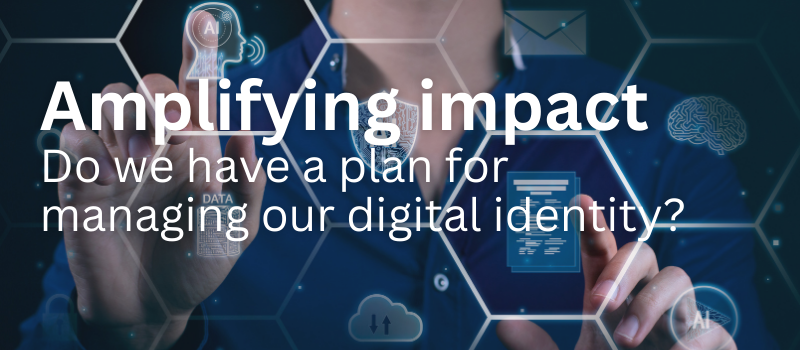- Home
- Public communication
- Amplifying impact: Do we have a plan for managing our digital identity?
Amplifying Impact: Do We Have A Plan for Managing Our Digital Identity?

We take care of our physical identity in several ways, but do we do the same with our digital identity, and with the same level of care? Digital identity refers to our online representation of ourselves and serves to gather all of the information and attributes that uniquely identify who we are and what we stand for. This may include, among other things, information such as our personal details, login credentials, our financial records, the content we publish on websites or applications, and social media.
The unique feature of digital media is that almost every interaction, whether with a website, online service or digital application, results in the collection of personal information of some kind. Each of these interactions can potentially identify us, even if, in the end, some of this data may be de-identified.
Some professional communicators may choose not to use social media platforms, such as LinkedIn, to maintain an active presence. They may choose not to comment on other people’s posts or to create fresh content of their own.
Depending on the industry sector they work in, it may be that their target audience is not actively engaged on LinkedIn, and they may choose to prioritise other platforms that are better aligned with their audience’s preferences.
It may also be about not having sufficient time and resources. Social media management can be all-consuming, from planning the type of content to publish, figuring out supporting artwork and digital assets that will inspire and engage, to maintaining a ready and consistent flow of material that goes beyond the typical fare.
Sometimes, reluctance may stem from a negative experience.
Trolling behaviour, piled-on attacks, and trigger-happy keyboard warriors can appear out of nowhere. Their reactions, comments and the resulting negative experience can be quite debilitating if they hit a raw nerve. Stepping off completely and avoiding such occurrences may be an easier option than putting yourself in harm’s way repeatedly.
If we look at what seems to pervade current conversations and make the news, we will see a very strong focus on artificial intelligence (AI) today.
New applications are being released to the market, and there is a lot of hype and conversation constantly being generated about them. However, alongside this, there are warnings about job losses, plagiarism, the need for a pause, government regulation, and much more.
As certain tasks get automated, certain industry sectors and roles may have to contend with job losses. We also see a rise in cyber warfare and hacking, even more “deep fakes”, and worries around digital identity theft.
It is not surprising, therefore, that there is some concern about how we are to manage our digital identities and digital footprints in this ever-evolving landscape. LinkedIn provides a social media platform which allows us to manage our digital identity if we create an account.
Our challenge lies in evaluating the landscape and anticipating challenges that may emerge in any kind of digital platform or environment over the next several years. The question we need to ask ourselves is: Do we even have a solid plan for how we manage and secure our digital identities?
As professional communicators, our job involves conveying information, messages, and ideas to specific target audiences on behalf of an organisation or an individual. We may work in fields such as public relations, marketing, advertising, journalism, corporate communications, and much more.
What is our goal as professional communicators?
We want our messages to be clear and persuasive. Our aim is to engage others, which may involve multiple stakeholders, through our communication efforts.
Some individuals choose to step away from public discourse (at least, digital discourse) because they are concerned about how their identity is managed or represented.
As communicators, our roles involve communicating, presenting, engaging, defending, promoting and sharing ideas and messages. It is wise to anticipate that our identities may be interlinked at times, or even perceived to be so and to be prepared to deal with this.
Therefore, it is understandable that there are concerns about the manner in which our identities, and even our digital identities, are to be managed and protected, depending on the issues at hand.
There may be times when we promote and encourage an issue where we may be happy to allow our identities to be intertwined with the issue. We may choose to publicly support an issue as individuals and not simply present a message on behalf of the organisation we represent.
In the same way, there may also be times when we communicate organisational messages that we may not necessarily feel aligned with, and which we may choose to distance ourselves from as individuals. Generally, these relate to methods of outreach rather than to matters of principle. Professional communication carried out with skill and subtlety may still be possible in such circumstances
This can be an ever-changing environment in which our positions on key issues or unfolding circumstances may not be entirely clear to us in the moment. This makes having a plan around how we choose to position ourselves and manage our digital identities extremely relevant.
You may not have all the answers to this issue just yet, but I propose that being intentional about our digital identity is something we need to pay serious attention to.
Let’s be intentional about the choices we make, as failing to decide over a period of time is still a decision.

Rowena Morais is an international freelance editor, ghostwriter and LinkedIn profile writer. She is the IABC Canberra Director of Member Communications and an IABC Canberra Board member.